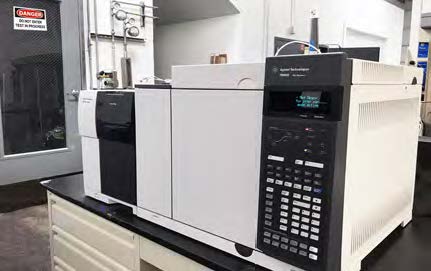Gas Chromatograph and Mass Spectrometer Combustion Analysis
By: Jeffery Griffin, Chief Commercial Officer, Fauske & Associates
 |
| FAI uses an Agilent Mass Spectrometer and Gas Chromatograph in our flammability laboratory |
A Gas Chromatograph (GC) and Mass Spectrometer (MS) are instruments commonly used in analytical labs. The combined equipment generally referred to as a GC/MS is an analytical technique used to separate, identify and quantify different compounds within a sample.
Fauske & Associates (FAI) recently added these instruments to our tool set to support our growing flammability testing and analytical testing businesses as the tool is helpful in numerous applications:
1.) Combustion analysis
2.) Post-reaction mixture analysis (this has applications for reaction calorimetry and thermal hazards)
3.) Quality control (QC concerns/assessment)
4.) Vapor-liquid equilibrium (VLE) studies
5.) Environmental /pesticide
This article explores how the GC can be used for combustion analysis. The primary applications for combustion analysis are twofold:
1.) Before combustion – GC can be used to accurately ascertain fuel/oxidizer ratio (especially in mixtures with multiple components)
2.) After combustion – GC can be used to measure the composition and quantities of combustion gases generated by an event
Dr. Ashok Dastidar, Vice President, Dust & Flammability Testing and Consulting Services explains, “Generally, when flammability testing is performed, the mixture composition is estimated based on partial pressures of the materials as they are added into the test chamber and the assumption that the mixture is adhering to the ideal gas law. While this approach can result in an acceptable approximation of the fuel-oxygen ratio under investigation, there is opportunity for improvement that can be helpful in certain applications.
Specifically, more detailed understanding of the composition can be important if a client has a safety concern or if they are interested in having a high-level of accuracy.”
In a safety scenario - identification of combustion products is important especially when reviewing an event such as a fire or an explosion. Depending on the mixture (fuel-oxygen ratio), different combustion byproducts can result. For example, a test with a fuel rich mixture might result in hazardous byproducts that could be dangerous for people or the environment. Better knowledge of a material could help inform a risk-based approach to mitigate potential exposures.
As an example, if a company has a solvent tank, and an explosion occurs in the headspace, combustion gases will be released. With a more robust assessment of their combustion products, the company would have a better idea of what safety conditions they should design for. They might implement different controls to mitigate the risk of explosion or keep the fuel-oxygen ratio under different conditions because the environmental impact would be lower. For a company interested in mitigating risk, this could be very helpful. Depending on the specific composition of the fuel or the nature of the fuel/oxygen ratio when you test, you might end up with different combustion products.
While someone could perform theoretical calculations to develop a model of what combustion products could be in an explosion scenario, test data is helpful in quantifying reality. Testing is a good complement to models and can provide validation input when performing dispersion modeling or developing a safety plan.
Is There Any Standard That Requires This Analysis?
There is no specific standard for the combustion application of the GC, however, there have been discussions by some international testing bodies on putting requirements for measuring composition by GC into the standard. For other applications mentioned above, regulatory bodies like the EPA and others have standards available.
For more information regarding GC and your flammability testing needs, contact us today.

